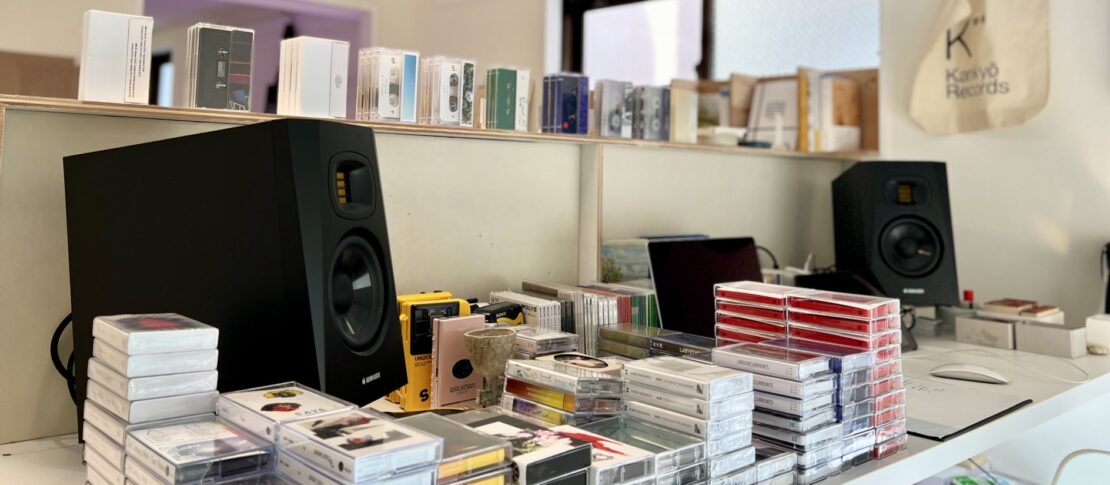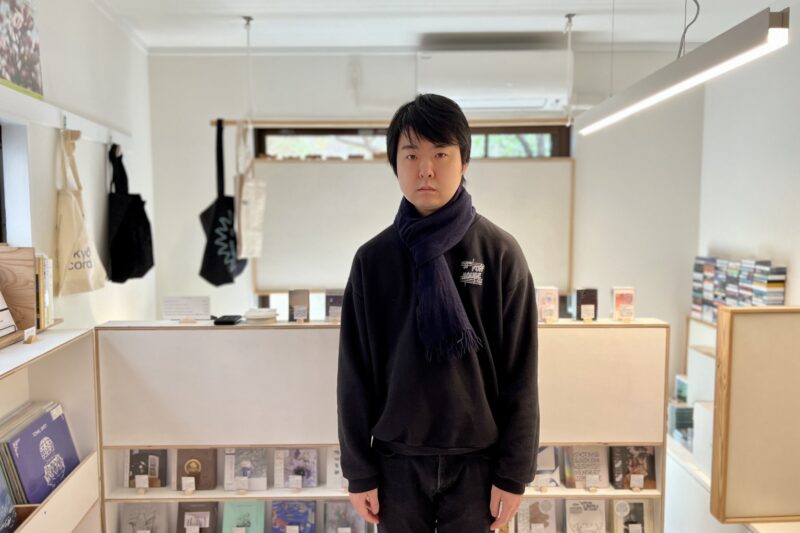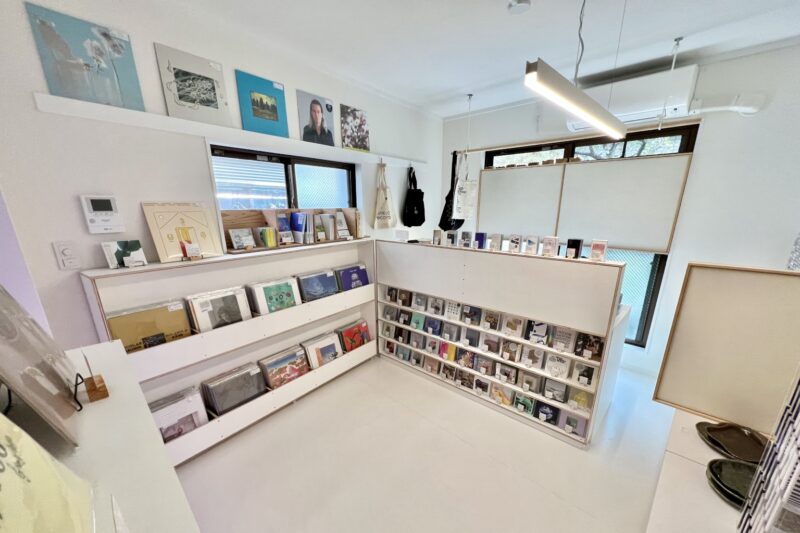
Interview with H. Takahashi [Kankyo Records]
Kankyo Records is a record store run by ambient music producer H Takahashi, opening in 2021 in a housing complex in the suburbs of Sangenjaya, Tokyo. With a focus on the modern society where people spend more and more time at home, Kankyo Records offers a wide selection of Ambient and New Age music from around the world, carefully selected for home listening under the theme of “listening in the living environment”.
Looking also at the living environment itself, Kankyo Records carries audio equipment and furniture selected based on the concept of “listening experience in a better environment”. Alongside running Kankyo Records, H. Takahashi is an architect and Kankyo Records also offers space design, acoustic design, furniture production, and other services under the name of H. Architecture.
Hello there! Thanks for taking the time to talk with us. Let’s get right to it: Why have you started Kankyo Records?
Alongside my activity as an ambient music producer, I have been working at architectural firms, and I wanted to bring those two elements together. One of the first ambient music that I listened to and influenced me a lot is “Music for Airports” by Brian Eno. When I discovered this album, I noticed similarities between this type of music and architecture, and I have been wanting to offer architectural space design and music production/curation together as my service.
How did you discover ambient music?
Before going deep with ambient music, I listened a lot to rock bands like “Talking Heads” and “Roxy Music”. Brian Eno was a name I saw a lot when listening to these bands, and just when I was studying architecture in university, I came to know that Brian Eno is doing music that is very different from Rock, and I got very curious. And when I first listened to his “Music for Airports” album, I was shocked by how conceptually different it was from the kind of music that I have been listening to. From that time, I started digging ambient music.

You are also active as an ambient music producer. How did you start creating your own music?
After graduating from university, I started to work at an architectural firm. During these days, I was continuing to listen to music mainly from the 70s and 80s. It was artists like Tangerine Dream, Ash Ra Tempel, Steve Reich, Jon Cage and so on. But one day I discovered a record store in Kyoto called “Meditations”, and there I found a lot of ambient music that was being created now, and not from the 70s and the 80s. This inspired me to try creating my own music of this style. It was when “Garageband” just became available on iPhone, and this also allowed me to get into music production without too much hustle. To this day, Garageband on iPhone is still my main instrument for creating music.
Your store is specializing in physical media of music such as Vinyl, Cassette Tape and CD. Do you see any special relationship between ambient music and physical media?
A lot of people these days listen to music on streaming services using smartphones. While this is surely one way of listening and enjoying music, the music curation is a lot of the times dependent on AI and the listeners can be passively listening to the songs without even knowing what the music is and who they are. Physical media, on the other hands, prompt the listeners to choose the music they want to listen to. Each music has its own distinct characteristics and atmosphere, and in a way the listeners are choosing the atmosphere they want to be in by themselves rather than having the AI choose it for you.
I like this idea of the listeners being conscious of the atmosphere they want to be in. Music is a very sensitive style of art, and more care can be put into what you listen to and how you would like to spend the day. Physical media also requires your involvement in actually playing the music. For example, if you are listening to vinyl, you would need to put the needle on the record and flip it to listen to the other side. I think this also makes the listeners to become more conscious to the music they are listening to.
How do you see the differences of each physical media, vinyl, tape and CD?
I’ve always felt that the interaction between the music and its artwork is very important. With vinyl, the artwork can be laid out in a larger size, and when the artwork is as beautiful as the music itself, it makes me love that music more. Vinyl is also special in its sound quality and the way it generates sound. The vibration is created from the small grooves that are cut on the vinyl, and I like this kind of physical technology being sustained and appreciated by the listeners for a long time.
Cassette tape is another interesting media. It is far from accurate sounding most of the time as there are a lot of noise, wow and flutter, but listening to cassette tapes is all about that error and randomness, and it is simply a fun thing to do. The compact form factor also makes you want to collect these items. For me, cassette tape is probably the format that I like the most. My very first release was also on cassette tape.
CD, for me, is the most familiar format. I bought a lot of used CDs from my teenager days. I like the fact that it is thin, compact, and portable, and reading the liner notes helped a lot to understand more about the artist and the music. In the pre-internet days, information was scarce and liner notes were always a good source of information.

How do you curate your music?
These days, I like listening to music together with friends in a small environment like somebody’s home or apartment. In these listening sessions with close friends, I can discover new music and talk about music. This is really fun and has a lot of effect in the music that I curate at Kankyo Records.
The Kankyo Records store is equipped with ADAM Audio T5V studio monitors. How did you get to know our speakers?
A close friend of mine has an A3X + Sub7 set up in his design office for listening purposes, and this is one of the places I had been visiting to hold the listening sessions I mentioned earlier. When I first heard the ADAMs there, I was surprised by its clarity and how it can reveal the small details. It not only affected the way I produce my own music, but it enabled me to appreciate the music more, as I was able to hear everything in the music and thus being immersed in the music fully. From this experience, I wanted to offer the same kind of experience to my customers. Speaker is the key element for connecting the music and the space.
About H. Takahashi
Born in Tokyo, he started composing music using iPhone in 2014, and formed the ambient group “UNKNOWN ME” with Yakenohara, P-RUFF, and Yudai Osawa in 2016. His latest release is Paleozoic from Dauw, and has also released from labels such as Constetaion Tatsu, Not Not Fun, Where to Now?, Muzan Editions and White Paddy Mountains.
Learn mor about Kankyo Records and H. Takahashi here:
![Interview with Bas Oskam [Noisecontrollers]](https://www.adam-audio.com/blog/wp-content/uploads/resized/2021/11/adam-audio-blog-interview-with-bas-oskam-from-noisecontrollers-thumbnail-300x200-c-default.jpg)
